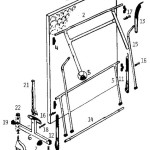Square Foot Vegetable Garden Plans: Essential Aspects for Success
Square foot vegetable gardens are a fantastic way to maximize space and grow a wide variety of vegetables in a small area. With their meticulous planning and efficient design, these gardens offer numerous advantages, including increased productivity, water conservation, and ease of maintenance.
Creating a successful square foot garden requires careful planning and attention to essential aspects. These include:
1. Site Selection and Soil Preparation
Choose a well-drained site that receives at least 6 hours of sunlight per day. The soil should be fertile, have good water-holding capacity, and be well-aerated. Amend the soil with organic matter, such as compost or manure, to improve its fertility and structure.
2. Grid and Square Division
Divide the garden bed into square foot blocks using string or stakes and twine. Each square should be 1 foot by 1 foot (or 30 centimeters by 30 centimeters). This grid structure forms the foundation of the square foot method.
3. Plant Selection and Spacing
Choose vegetables that are compatible for square foot gardening and consider their mature size and spacing requirements. Plant according to the recommended plant spacing guide for each species. Utilize vertical space using trellises or stakes for vining plants like tomatoes and beans.
4. Companion Planting and Intercropping
Interplant compatible vegetables in close proximity to benefit from companion planting. For example, planting carrots next to onions can deter carrot flies, while planting basil around tomatoes can improve tomato growth and flavor.
5. Water Management and Fertilization
Water the garden regularly, especially during dry periods. Use a soaker hose or drip irrigation system to deliver water directly to the root zone. Fertilize the plants with a balanced fertilizer every few weeks to provide essential nutrients.
6. Disease and Pest Management
Implement disease and pest management practices to maintain a healthy garden. Use organic pest control methods, such as companion planting, crop rotation, and natural predators. Monitor plants regularly for signs of disease or pests and take appropriate action when necessary.
7. Mulching and Weed Control
Spread a layer of mulch around the plants to suppress weeds, retain moisture, and regulate soil temperature. Use organic materials like straw, hay, or wood chips as mulch.
8. Succession Planting and Season Extension
Plan for succession planting to extend the growing season. Sow or transplant new crops as soon as the previous crop is finished or harvested. Utilize cold frames or greenhouses for early-season planting or to extend the season into fall or winter.
By following these essential aspects, you can create a productive and successful square foot vegetable garden. With its efficient design, thoughtful planning, and sustainable practices, this gardening method offers an excellent way to grow a variety of fresh vegetables in a limited space.
Free Square Foot Gardening Plans

5 000 Sq Ft Vegetable Garden Plan Happihomemade With Sammi Ricke

Square Foot Garden Planner

Planning A Square Foot Garden Pros And Cons Sample Plans The Old Farmer S Almanac

Pin On Garden Inspiration And How To S

Square Foot Gardening Vegetables Just Got A Whole Lot Easier

Pin On Grow

Square Foot Garden Spacing For Big Harvests Free Chart

Square Foot Garden Plans For Spring Onecreativemommy Com

Square Foot Gardening Bonnie Plants








